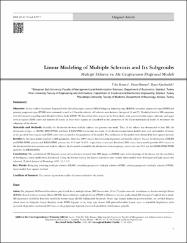| dc.contributor.author | Karaca, Yeliz | en_US |
| dc.contributor.author | Osman, Onur | en_US |
| dc.contributor.author | Karabudak, Rana | en_US |
| dc.date.accessioned | 2019-10-29T17:32:36Z | |
| dc.date.available | 2019-10-29T17:32:36Z | |
| dc.date.issued | 2015 | |
| dc.identifier.issn | 1301-062X | |
| dc.identifier.issn | 1309-2545 | |
| dc.identifier.uri | https://dx.doi.org/10.4274/tnd.82957 | |
| dc.identifier.uri | https://hdl.handle.net/20.500.12294/1779 | |
| dc.description | WOS: 000362665700002 | en_US |
| dc.description | Osman, Onur (Arel Author) | en_US |
| dc.description.abstract | Objective: In this study, 120 patients diagnosed with clinical multiple sclerosis (MS) of relapsing remitting type (RRMS), secondary progressive type (SPMS) and primary progressive type (PPMS) were examined, as well as 19 healthy subjects. All subjects were between the ages of 20 and 55. Disability levels of MS symptoms were determined using Expanded Disability Status Scale (EDSS). We focused on three regions in the brain, brain stem, periventricular corpus callosum, and upper cervical regions EDSS scores and number of lesions in these three regions are considered as the parameters of the linear mathematical model to determine the subgroups of the disease. Materials and Methods: Initially, the distinction between healthy subjects and patients was made. Then, if the subject was determined to have MS, the distinction of type, i.e. RRMS, SPMS/PPMS, and later, RRMS/SPMS distinction was made. In all determinations linear models were used and number of lesions in the specified three regions and EDSS scores were assumed as the parameters of the model. The coefficients of the models were obtained by least squares method. Results: In the linear model attached to MR parameters, there was 100% success for distinction of patients and healthy subjects. Success for distinction of RRMS and SPMS/PPMS patients and RRMS/SPMS patients was 94% and 78.94%, respectively is attained. Based on EDSS scores, linear model provides 99% success in the distinction between patients and healthy subjects. In the models created for the distinction between groups, success rate was 94% was for RRMS-SPMS/PPMS and 64% for RRMS/SPMS. Conclusion: The correlation of MS diagnosis using various features obtained from MR images and EDSS scores with subgroups of the disease and the possibility of developing a linear model were determined. Using the features having the highest correlation rate, various linear models were developed and high success was achieved. | en_US |
| dc.description.sponsorship | Turkish Neurological Association | en_US |
| dc.description.sponsorship | The authors are deeply grateful to Hacettepe University Medical Faculty, Neurology and Radiology Department in Primer Magnetic Resonance Imaging Center, and to radiologists Eray Atli MD. and Mehmet Yorubulut MD., for their cooperation in both the the domain knowledge and in the manual segmentation of the input dataset. Also, Yeliz Karaca MD. expresses gratitude to the Turkish Neurological Association for all their support. | en_US |
| dc.language.iso | eng | en_US |
| dc.publisher | Turkish Neurological Soc. | en_US |
| dc.relation.ispartof | Turkish Journal of Neurology | en_US |
| dc.identifier.doi | 10.4274/tnd.82957 | en_US |
| dc.identifier.doi | 10.4274/tnd.82957 | |
| dc.rights | info:eu-repo/semantics/openAccess | en_US |
| dc.subject | Relapsing remitting multiple sclerosis (RRMS) | en_US |
| dc.subject | secondary progressive multiple sclerosis (SPMS) | en_US |
| dc.subject | primary progressive multiple sclerosis (PPMS) | en_US |
| dc.subject | linear model | en_US |
| dc.subject | least squares method | en_US |
| dc.title | Linear Modeling of Multiple Sclerosis and Its Subgroubs | en_US |
| dc.type | article | en_US |
| dc.department | İstanbul Arel Üniversitesi | en_US |
| dc.identifier.volume | 21 | en_US |
| dc.identifier.issue | 1 | en_US |
| dc.identifier.startpage | 7 | en_US |
| dc.identifier.endpage | 12 | en_US |
| dc.relation.publicationcategory | Makale - Uluslararası Hakemli Dergi - Kurum Öğretim Elemanı | en_US |
| dc.department-temp | [Karaca, Yeliz] Suleyman Sah Univ, Fac Management & Adm Sci, Dept Econ, Istanbul, Turkey -- [Osman, Onur] Arel Univ, Fac Engn & Architecture, Dept Elect & Elect Engn, Istanbul, Turkey -- [Karabudak, Rana] Hacettepe Univ, Fac Med, Dept Neurol, TR-06100 Ankara, Turkey | en_US |


















